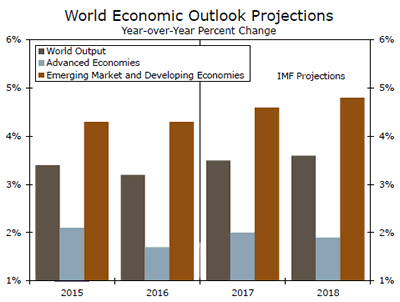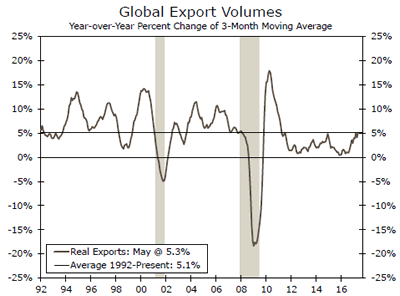U.S. Review
The U.S. Economy Rose 2.6 Percent in Q2
- The first look at economic growth in the second quarter came in at 2.6 percent, boosted by strong performances in personal consumption, nonresidential investment and trade.
- Earlier in the week, new data on the housing market, new and existing home sales and home prices, all came in close to expectations and pointed to healthy demand running into supply constraints. Consumer confidence surprised to the upside for July as did the durable goods report for June.
GDP Growth Comes Back in Q2
As we expected, economic growth bounced back in the second quarter, up 2.6 percent after a downwardly revised 1.2 percent growth in Q1. There were few surprises; personal consumption, nonresidential investment, government and trade were all supportive of second quarter growth. Residential investment declined after an outsized Q1 gain, and change in inventories had very little effect.
Residential fixed investment fell 6.8 percent in Q2 following its impressive 11.1 percent increase in the first quarter. Mild weather was a boost to construction in the winter months, which was partially at play in the Q1 jump. With more normal weather in the spring, the housing market in Q2 reflected two competing economic pressures; strong income and job growth is pushing up demand while the supply of available homes remains stubbornly lean. Home sales data for June underscored this imbalance. Existing home sales declined more than expected, falling 1.8 percent to a 5.52M-unit annual pace. Much of the crowding out has been on the lower end of the price range. Homes priced less than $250,000 account for the smallest share of sales in four years, when the National Association of Realtors began tracking the distribution. The resulting pressure on home prices continues to build; both median and average prices of resales were at record highs in June. We looked closely at home price measures in our publication Western Markets Drive Home Prices Higher this week, which is available on our website or by request. New home sales rose slightly in June, but downward revisions to previous months brought the Q2 sales level below that of Q1, which was reflected in the GDP print this morning. On a positive note, the median price for a new home declined in June as sales shifted toward lower priced homes—a welcome development for firsttime buyers.
The Conference Board’s Consumer Confidence index surprised to the upside in July. The University of Michigan’s consumer sentiment survey indicated election euphoria was wearing off, though the confidence measure disputed that notion. Mixed messages from the two measures of the mood of the consumer, the most important source of economic growth, bear watching. Confidence about the present situation is the highest it has been since the early 2000s, as consumers are increasingly finding jobs plentiful. Consumer sentiment about the current situation has also skyrocketed in recent years, echoing the idea that the U.S. economy is on solid footing and more consumers are benefitting from it. The two surveys also show diminished expectations, though the confidence survey reversed in July, which suggests the unease over Washington gridlock may have a smaller impact on the consumer than initially thought.
A strong jump in aircraft orders boosted durable goods orders by 6.5 percent in June, though orders excluding transportation, a proxy for future activity, eased from May’s stronger-than-firstreported showing. Core shipments, a proxy for current business investment, also eased somewhat. The three month annualized rate softened to its lowest pace this year for both orders and shipments of core capital goods.


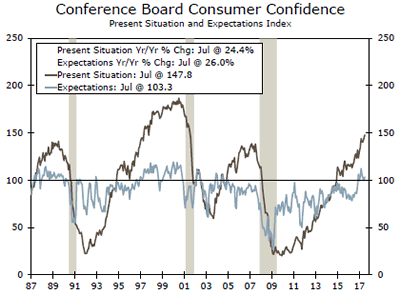
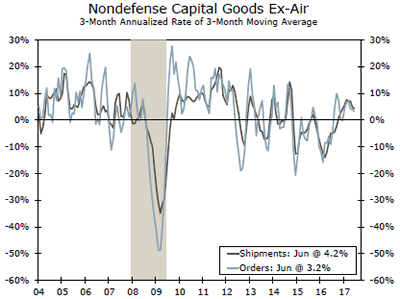
U.S. Outlook
Personal Income • Tuesday
Personal income growth accelerated in April and May, rising 0.3 and 0.4 percent, respectively. The continued pace of job growth has helped to maintain momentum behind income growth since the beginning of the year. More importantly, in our view, for the prospects for real consumer spending growth is real disposable income, which rose 0.6 percent in May. The low inflation environment that has persisted over the last few months has helped to lift discretionary income for consumers. The headline PCE deflator has declined in two of the last three months. On a yearover- year basis the headline deflator is up just 1.4 percent. We expect another soft inflation print in June with a flat reading. We also expect personal income growth remained steady at 0.3 percent in June, which supports our case for continued gains in real consumer spending in the second half of the year.
Previous: 0.4% Wells Fargo: 0.3% Consensus: 0.4%
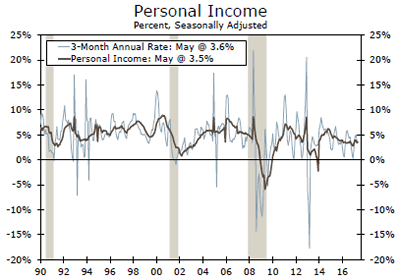
ISM Manufacturing • Tuesday
The Institute for Supply Management’s manufacturing survey jumped 2.9 points in June to 57.8, the highest reading since August 2014. The forward-looking new orders component also rose sharply from 59.5 in May to 63.5 in June. While the optimism among the manufacturing sector is welcome news, we are skeptical that such a robust trend can continue for a couple of reasons. First, we saw a surge in business investment in Q1 which downshifted in the second quarter. With only modest improvement in global demand, we do not see business investment accelerating much in the second half of the year. Second, the surge in optimism coincided with expectations for a large corporate tax cut. While we still assume some tax cuts will take place, we are skeptical that they will be large. Looking ahead to July’s reading, we expect the ISM manufacturing reading pulled back to 56.1 for the month.
Previous: 57.8 Wells Fargo: 56.1 Consensus: 56.4

Employment • Friday
Nonfarm payrolls rose by 222,000 in June while the unemployment rate edged higher to 4.4 percent. One of the more disappointing aspects of the report was the very modest rise in average hourly earnings. While there have been minor month to month fluctuations in the headline nonfarm number, as can be seen in the graph to the right, the 12-month average has remained relatively steady over the past several months at 187,000. Looking ahead to next Friday’s employment situation release for July, we estimate that nonfarm payrolls increased by 195,000 in July and the unemployment rate fell back to 4.3 percent. As the year progresses, we continue to estimate average monthly job growth in the 150,000 range and expect the unemployment rate to fall to 4.2 percent by the fourth quarter of this year.
Previous: 222,000 Wells Fargo: 195,000 Consensus: 180,000
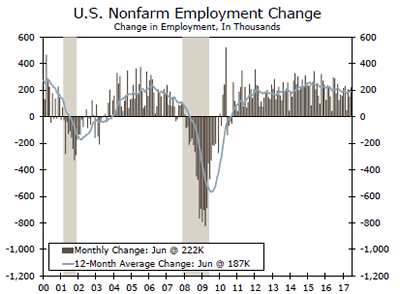
Global Review
Lack of Inflation in Japan Buys BoJ More Time
- The year-over-year rate of CPI inflation in Japan came in at just 0.4 percent in June. The Bank of Japan (BoJ) is the only major foreign central bank not even discussing normalization of accommodative monetary policy. Given these inflation numbers, there is no hurry.
- In this week’s Global Review on page 4 we also discuss the latest GDP figures for the U.K. and Korea as well as the latest signals of business activity in Europe.
Eurozone PMIs: Less "Robust"
After ECB President Draghi’s reference last week to the "robust recovery" going on in the Eurozone, financial markets started this week with news that the July business activity in Europe was weaker than expected. While the PMIs have been in expansion territory for the past four years, only recently have they broken north of 55. Although this gauge of business sentiment slipped in July, the current level for both the manufacturing and the service sector remains above 55; still consistent with steady expansion. As we discuss on the next page in the International Outlook, next week brings the first look at GDP data for Q2.
Soft U.K. GDP Means Less Urgency for Bank of England
Recent meetings of the Bank of England’s (BoE) Monetary Policy Committee have shown growing dissent over keeping rates unchanged with some members calling for rate increases. The shift to a more hawkish bias was one of a number of factors driving British pound sterling higher over the past few months.
The momentum toward an eventual rate hike has been dealt with a series of modest setbacks beginning with a June CPI report released last week which showed virtually no inflation in the month-over-month rate for June. Then earlier this week, we learned that second quarter GDP growth in the United Kingdom remained modest. After a 0.2 percent increase in the first quarter, the economy there grew 0.3 percent (1.2 percent annualized) in the second.
Given the soft inflation backdrop, we expect the BoE will refrain from raising rates through at least the end of 2017. Our forecast looks for real GDP growth in the United Kingdom to strengthen modestly in 2018, although uncertainty related to Brexit continues to lurk in the background as a major downside risk to the economy.
Korean Economy Poised for Growth Despite Tepid GDP
The Korean economy downshifted in Q2 partly due to a slowdown in trade. But a newly announced economic plan and indications of détente in the trade spat with China suggest upside potential in the second half.
Additionally, the Korean government announced a new 5-year economic plan which aims to maintain expansionary fiscal policy to support what it reckons will be 3.0 percent growth this year, up from 2.6 percent previously. The Bank of Korea also revised its own forecast, lifting the full-year growth figure to 2.8 percent.
Lack of CPI Inflation Justifies Dovish Stance at BoJ
At its policy meeting last week, the Bank of Japan maintained its comprehensive program of policy easing with no clear end in sight, even as other central banks are at least talking about the eventual normalization of monetary policy.
Japanese CPI came in this week at just 0.4 percent year over year, which justifies the BoJ’s accommodative stance. Aside from a brief spurt after the 2014 consumption tax, sustained inflation north of 2.0 percent has not been achieved since the early 1990s.
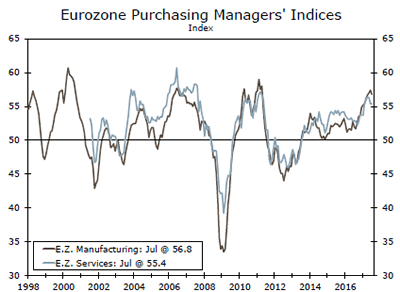
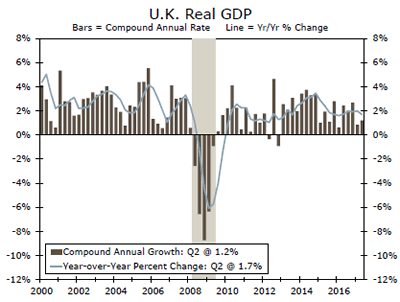
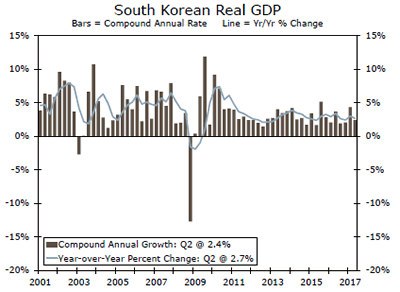
Global Outlook
Mexican GDP • Monday
Much like the colossus sitting on its northern border, the Mexican economy has been growing at an uninspired pace over the past few years. In recent quarters, real GDP growth has been driven by the primary sector (agriculture) and the tertiary second (services). In contrast, growth in the secondary sector (manufacturing, mining and construction) has generally been weak, although manufacturing output has accelerated in recent months. The pickup in manufacturing production in Mexico is due, at least in part, to strength in auto exports.
The consensus forecast looks for some payback in the year-overyear real GDP growth rate in Q2 from the relative strength that was registered in Q1. That said, most analysts, ourselves included, look for the Mexican economy to slowly pick up steam in coming quarters as global GDP growth continues to firm.
Previous: 2.8% (Year-over-Year) Consensus: 1.9%
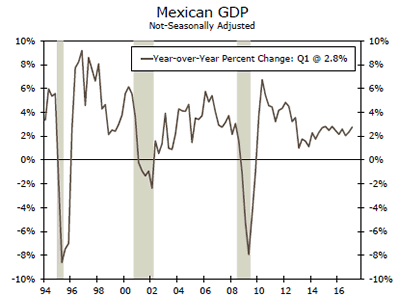
Eurozone GDP • Tuesday
Real GDP in the Eurozone grew 0.6 percent (not annualized) in Q1-2017, the strongest rate of sequential growth in two years. Moreover, the expansion is becoming increasingly self-sustaining as the drivers of growth are broad based and not concentrated in one sector or one spending category. We and the consensus look for another solid growth performance in Q2.
Nevertheless, inflationary pressures in the euro area are benign at present. In that regard, the "flash" estimate of CPI inflation in July will be on the docket on Monday. Unless inflation should rise suddenly, which we think is unlikely, the ECB likely will continue to maintain an accommodative policy stance for the foreseeable future. The July PMIs for the manufacturing and service sectors will also print next week, although they likely will not be materially different from the preliminary estimates that were released last week.
Previous: 0.6% (Quarter-on-Quarter) Wells Fargo: 0.5% Consensus: 0.6%
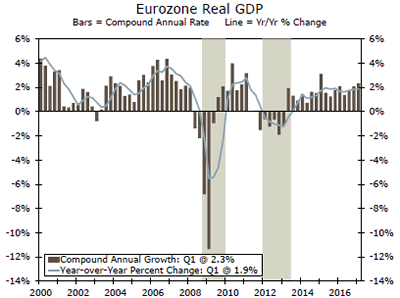
Bank of England Policy Meeting • Thursday
Following its 25 bps rate cut last August in the immediate aftermath of the Brexit referendum, the Monetary Policy Committee (MPC) has maintained its main policy rate at 0.25 percent. In our view, there is a high probability that the MPC will keep the Bank Rate unchanged at its August 3 policy meeting as well as for the foreseeable future. As noted on page 4, real GDP grew only 1.2 percent at an annualized rate in Q2-2017. Although CPI inflation is currently running above the MPC’s target of two percent, slow economic growth in conjunction with the recent stability in the value of sterling should cause inflation to recede in coming months.
There are very few data points from the third quarter yet, although next week’s release of the manufacturing PMI (Tuesday) and the service sector PMI (Thursday) will give analysts some insights into the present state of the British economy.
Previous: 0.25% Wells Fargo: 0.25% Consensus: 0.25%
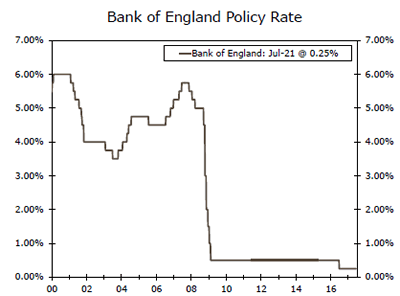
Point of View
Interest Rate Watch
Defining Normalization
Since the 2008-2009 recession, the PCE deflator has consistently averaged less that the two percent target that the FOMC has identified. In fact, in only one year, 2011, did the pace of the PCE deflator exceed two percent and that one year result reflected a coincidence of transitory factors. The year 2011 was characterized by a jump in oil prices, dollar weakness which boosted import prices for energy and food and then finally the earthquake in Japan which lifted auto prices.
Late Cycle Pressures
As the economic cycle matures, increases in economic growth typically are associated with a reduction in the remaining economic resources that are idle and therefore the price for these resources is bid up. This provides the basis for the expectation at the FOMC that inflation rises as the cycle matures.
Yet, as illustrated in the middle graph, the PCE projections for 2017 did not reflect an acceleration of the PCE measure of inflation and in fact the projections dropped even as the unemployment rate declined.
If resource constraints matter, why not an acceleration of inflation in 2017 as the unemployment rate declined?
Over the Long Run, Real interest Rates to Rise?
Long-run unemployment rate projections, bottom graph, illustrate the FOMC expectations that the unemployment rate would decline and, given a Phillips model, the expectation for inflation to rise.
With the Phillips model projection of higher inflation, the FOMC would be expected to raise the nominal FFR over the next year at a pace in excess of the expected increase in the rate of inflation implied by the FOMC projections. Moreover, reduction in the Fed balance sheet would put added upside pressure on benchmark U.S. Treasury rates.
Net, real interest rates would be expected to rise with an anticipated negative impact on economic growth.

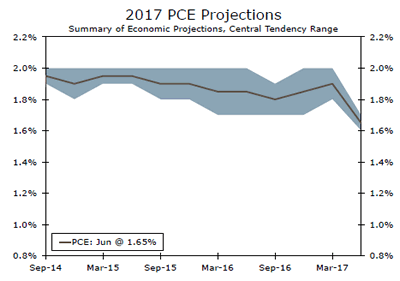
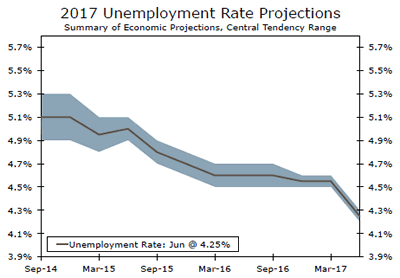
Credit Market Insights
Confidence Suggesting Loan Growth?
The Conference Board’s Consumer Confidence Index revealed continued widespread optimism in June. The present situation index as well as the future expectations index increased over the month, while the difference between the jobs plentiful and jobs hard to get indices indicates that expectations are for the unemployment rate to continue its descent. This most recent reading was the second highest in 16 years, reflecting the significance and scope of optimism.
Interestingly, plans to buy in the June report were mixed despite this level of confidence. Plans to buy a home jumped to 6.7 percent over the month from 6 percent the month prior, while plans to buy an automobile creeped up slightly to 12.7 percent, up from 12.6 percent. While survey responses do not necessarily translate into action, the increased plans and desire of consumers to purchase large items, such as homes and automobiles, could signal a spike in demand in mortgage and consumer loans. Auto loans in particular have shown growth, up 9.0 percent over the year, but have not quite reached pre-recession levels, while mortgage debt has grown at a slower pace. However, putting a damper on these encouraging plans to buy, consumers planning to buy major appliances dropped broadly on the month. This drop raises questions, as overall consumer confidence is soaring while actual consumer plans to buy major appliances has declined. However, we expect that consumer demand will catch up to confidence, and that consumer loans could experience a jump as well.
Topic of the Week
Something for Optimists and Pessimists Alike
The International Monetary Fund’s (IMF) July World Economic Outlook report portrayed the global economy as steadily improving. Although the IMF’s headline global growth forecast was unchanged, the forecast revisions diverged for two of the world’s largest economies.
The United States and the United Kingdom both saw downward revisions to economic growth projections for 2017, and the IMF shaved a sizable 0.4 percentage points off of its 2018 forecast for the United States. The IMF cited less expansionary fiscal policy assumptions as the key driver of its lower forecast. Outside of these two countries, most of the world’s advanced economies saw upward revisions in light of improved economic activity, including Canada, Japan and the euro area, particularly Spain and Italy.
China also received a small boost to its growth forecast, with the IMF now expecting real GDP to rise 6.7 percent in 2017 and 6.4 percent in 2018. The IMF sees the medium-term risks for China as tilted to the downside, however, as Chinese policymakers try to balance the competing demands of deleveraging while also keeping the economy’s deceleration to a minimum.
The rebound in global trade from 2015-2016 levels has helped to spur faster growth in the global economy. Our own outlook calls for real global growth to rebound to 3.4 percent this year and hold at that pace through 2018. Although some central banks have either embarked on tightening policy (the Fed, Bank of Canada) or hinted at tighter policy in the future (European Central Bank), on balance monetary policy in many of the world’s major economies remains relative easy. That said, a return to the supercharged growth of the past two expansions seems unlikely. Many of the world’s advanced economies are grappling with aging populations and sluggish productivity growth, while emerging market economies face still-low commodity prices and must innovate as the low-hanging economic fruit disappears.
